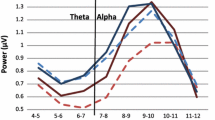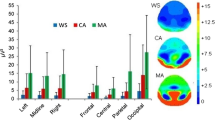Abstract
Attention-Deficit/Hyperactivity Disorder (AD/HD) is the most common psychiatric disorder of childhood and has been extensively researched using EEG technology. Within this literature, one of the most widely examined measures has been the theta/beta ratio. The theta/beta ratio was initially hypothesised to represent the arousal mechanism. However, subsequent research has shown this to be inaccurate and it was hypothesised that the ratio represents cognitive processing capacity. To examine that hypothesis, this study aimed to test the relationship between the P300 and the theta/beta ratio. The P300, absolute alpha and the theta/beta ratio were measured at Fz, Cz and Pz, and correlated in a group of 47 normal adults. A significant positive correlation was found between P300 latency and the theta/beta ratio. No relationship was found between P300 amplitude and the theta/beta ratio. P300 amplitude, but not latency, significantly correlated with alpha power. These results support the hypothesis that the theta/beta ratio is a marker of cognitive processing capacity.


Similar content being viewed by others
References
Andreassi, J. (2010). Psychophysiology, human behavior and physiological response (5th ed.). New York: Taylor & Francis group.
Barry, R., Clarke, A., & Johnstone, S. (2003a). A review of electrophysiology in attention-deficit/hyperactivity disorder: I. Qualitative and quantitative electroencephalography. Clinical Neurophysiology, 114, 171–183.
Barry, R., Johnstone, S., & Clarke, A. (2003b). A review of electrophysiology in attention-deficit/hyperactivity disorder: II. Event-related potentials. Clinical Neurophysiology, 114, 184–198.
Barry, R., Sokolov, J., E., N (1993). Habituation of phasic and tonic components of the orienting reflex. International Journal of Psychophysiology, 15, 39–42.
Barry, R. J., Clarke, A. R., Johnstone, S. J., McCarthy, R., & Selikowitz, M. (2009). Electroencephalogram theta/beta ratio and arousal in AD/HD: evidence of independent processes. Biological Psychiatry, 66, 398–401.
Barry, R. J., Clarke, A. R., McCarthy, R., Selikowitz, M., MacDonald, B., & Dupuy, F. E. (2012). Caffeine effects on resting-state electrodermal levels in AD/HD suggest an anomalous arousal mechanism. Biological Psychology, 89, 606–608.
Barry, R. J., Clarke, A. R., McCarthy, R., Selikowitz, M., Rushby, J. A., & Ploskova, E. (2004). EEG differences in children as a function of resting-state arousal level. Clinical Neurophysiology, 115, 402–408.
Barry, R. J., Kirkaikul, S., & Hodder, D. (2000). EEG alpha activity and the ERP to target stimuli in an auditory oddball paradigm. International Journal of Psychophysiology, 39, 39–50.
Barry, R. J., Rushby, J. A., Wallace, M. J., Clarke, A. R., Johnstone, S. J., & Zlojutro, I. (2005). Caffeine effects on resting-state arousal. Clinical Neurophysiology, 116, 2693–2700.
Brandt, M. E., Jansen, B. H., & Carbonari, J. P. (1991). Pre-stimulus spectral EEG patterns and the visual evoked response. Electroencephalography and Clinical Neurophysiology, 80, 16–20.
Callaway, E., Halliday, R., & Naylor, H. (1983). Hyperactive children’s event-related potentials fail to support underarousal and maturational-lag theories. Archives of General Psychiatry, 40, 1243–1248.
Chabot, R. J., & Serfontein, G. (1996). Quantitative electroencephalographic profiles of children with attention deficit disorder. Biological Psychiatry, 40, 951–963.
Clarke, A. R., Barry, R. J., Bond, D., McCarthy, R., & Selikowitz, M. (2002a). Effects of stimulant medication on the EEG of children with attention-deficit/hyperactivity disorder. Psychopharmacology (Berl), 164, 277–284.
Clarke, A. R., Barry, R. J., McCarthy, R., & Selikowitz, M. (1998). EEG analysis in attention-deficit/hyperactivity disorder: a comparative study of two subtypes. Psychiatry Research, 81, 19–29.
Clarke, A. R., Barry, R. J., McCarthy, R., & Selikowitz, M. (2001a). Age and sex effects in the EEG: Differences in two subtypes of attention-deficit/hyperactivity Disorder. Clinical Neurophysiology, 112, 806–814.
Clarke, A. R., Barry, R. J., McCarthy, R., & Selikowitz, M. (2001b). EEG-defined subtypes of children with attention-deficit/hyperactivity disorder. Clinical Neurophysiology, 112, 2098–2105.
Clarke, A. R., Barry, R. J., McCarthy, R., & Selikowitz, M. (2001c). EEG differences in two subtypes of attention-deficit/hyperactivity disorder. Psychophysiology, 38, 212–221.
Clarke, A. R., Barry, R. J., McCarthy, R., & Selikowitz, M. (2002b). EEG analysis of children with attention-deficit/hyperactivity disorder and comorbid reading disabilities. Journal of Learning Disabilities, 35, 276–285.
Clarke, A. R., Barry, R. J., McCarthy, R., & Selikowitz, M. (2002c). Children with attention-deficit/hyperactivity disorder and comorbid oppositional defiant disorder: an EEG analysis. Psychiatry Research, 111, 181–190.
Clarke, A. R., Barry, R. J., McCarthy, R., Selikowitz, M., Brown, C., & Croft, R. (2003a). Effects of stimulant medications on the EEG of children with attention-deficit/hyperactivity disorder predominantly inattentive type. International Journal of Psychophysiology, 47, 129–137.
Clarke, A. R., Barry, R. J., McCarthy, R., Selikowitz, M., Clarke, D., & Croft, R. (2003b). EEG in girls with attention-deficit/hyperactivity disorder. Clinical Neurophysiology, 114, 319–328.
Clarke, A. R., Barry, R. J., McCarthy, R., Selikowitz, M., & Croft, R. (2002d). EEG differences between good and poor responders to Methylphenidate in boys with the Inattentive type of ADHD. Clinical Neurophysiology, 113, 1191–1198.
Clarke, A. R., Barry, R. J., McCarthy, R., Selikowitz, M., & Heaven, P. (2011). Childhood EEG as a predictor of adult attention-deficit/hyperactivity disorder. Clinical Neurophysiology, 122, 73–80.
Clarke, A. R., Barry, R. J., McCarthy, R., Selikowitz, M., & Johnstone, S. (2007). Effects of stimulant medications on the EEG of girls with attention-deficit/hyperactivity disorder. Clinical Neurophysiology, 118, 2700–2708.
Clarke, A. R., Barry, R. J., McCarthy, R., Selikowitz, M., & Johnstone, S. (2008). The effects of imipramine hydrochloride on the EEG of children with attention-deficit/hyperactivity disorder. International Journal of Psychophysiology, 67, 35–40.
Clarke, A. R., Barry, R. J., McCarthy, R., Selikowitz, M., Magee, C., Johnstone, S., & Croft, R. (2006). The EEG in low IQ children with attention deficit hyperactivity disorder. Clinical Neurophysiology, 117, 1708–1714.
De Blasio, F. M., & Barry, R. J. (2013). Prestimulus alpha and beta determinants of ERP responses in the Go/NoGo task. International Journal of Psychophysiology, 89, 9–17.
De Blasio, F. M., Barry, R. J., & Steiner, G. Z. (2013). Prestimulus EEG amplitude determinants of ERP responses in a habituation paradigm. International Journal of Psychophysiology, 89, 444–450.
Donchin, E. (1981). Surprise!… surprise? Psychophysiology, 18, 493–513.
Duncan, C. C., Barry, R. J., Connolly, J. F., Fischer, C., Michie, P. T., Näätänen, R., Polich, J., Reinvang, I., & Van Petten, C. (2009).Event-related potentials in clinical research: Guidelines for eliciting, recording, and quantifying mismatch negativity, P300, and N400. Clinical Neurophysiology, 120, 1883–1908.
Duncan-Johnson, C. C., & Donchin, E. (1977). On quantifying surprise: The variation of event-related potentials with subjective probability. Psychophysiology, 14, 456–467.
Dykman, R., Holcomb, P., Oglesby, D., & Ackerman, P. (1982). Electrocortical frequencies in hyperactive, learning-disabled, mixed, and normal children. Biological Psychiatry, 17, 675–685.
Egner, T., & Gruzelier, J. H. (2004). EEG biofeedback of low beta band components: Frequency-specific effects on variables of attention and event-related brain potentials. Clinical Neurophysiology, 115, 131–139.
Fournier, L. R., Scheffers, M. K., Coles, M. G., Adamson, A., & Abad, E. V. (2000). When complexity helps: An electrophysiological analysis of multiple feature benefits in object perception. Acta Psychologica, 104, 119–142.
Hobbs, M. J., Clarke, A. R., Barry, R. J., McCarthy, R., & Selikowitz, M. (2007). EEG abnormalities in adolescent males with AD/HD. Clinical Neurophysiology, 118, 363–371.
Intrilligator, J., & Polich, J. (1995). On the relationship between EEG and ERP variability. International Journal of Psychophysiology, 20, 59–74.
Janzen, T., Graap, K., Stephanson, S., Marshall, W., & Fitzsimmons, G. (1995). Differences in baseline EEG measures for ADD and normally achieving preadolescent males. Biofeedback and Self-Regulation, 20, 65–82.
Jasikutas, P., & Hakerem, G. (1988). The effect of prestimulus alpha activity on P300. Psychophysiology, 25, 157–165.
Jasper, H., Solomon, P., & Bradley, C. (1938). Electroencephalographic analyses of behaviour problem children. American Journal of Psychiatry, 95, 641–658.
Johnson, R. (1986). A Triarchic Model of P300: For distinguished early career contribution to psychophysiology. Psychophysiology, 23, 367–384.
Johnson, R., & Donchin, E. (1978). On how P300 amplitude varies with the utility of the eliciting stimuli. Electroencephalography and Clinical Neurophysiology, 44, 424–437.
Klimesch, W. (1999). EEG alpha and theta oscillations reflect cognitive and memory performance: A review and analysis. Brain Research Reviews, 29, 169–195.
Klimesch, W., Sauseng, P., Hanslmayr, S., Gruber, W., & Freunberger, R. (2007). Event-related phase reorganization may explain evoked neural dynamics. Neuroscience and Biobehavioral Reviews, 31, 1003–1016.
Kropotov, J. D., Grin-Yatsenko, V. A., Ponomarev, V. A., Chutko, L. S., Yakovenko, E. A., & Nikishena, I. S. (2005). ERPs correlates of EEG relative beta training in ADHD children. International Journal of Psychophysiology, 55, 23–34.
Kutas, M., McCarthy, G., & Donchin, E. (1977). Augmenting mental chronometry: The P300 as a measure of stimulus evaluation time. Science, 197, 792–795.
Lazzaro, I., Gordon, E., Whitmont, S., Plahn, M., Li, W., Clarke, S., Dosen, A., & Meares, R. (1998). Quantified EEG activity in adolescent attention deficit hyperactivity disorder. Clinical Electroencephalography, 29, 37–42.
Lubar, J. (1991). Discourse on the development of EEG diagnostics and biofeedback for attention-deficit/hyperactivity disorders. Biofeedback and Self-regulation, 16, 201–225.
Mann, C., Lubar, J. H., Zimmerman, A., Miller, C., & Munchen, R. (1992). Quantitative analysis of EEG in boys with attention deficit hyperactivity disorder: Controlled study with clinical implications. Pediatric Neurology, 8, 30–36.
McGarry-Roberts, P. A., Stelmack, R. M., & Campbell, K. B. (1992). Intelligence, reaction time, and event-related potentials. Intelligence, 16, 289–313.
Monastra, V., Lubar, J., & Linden, M. (2001). The development of a quantitative electroencephalographic scanning process for attention deficit-hyperactivity disorder: Reliability and validity studies. Neuropsychology, 15, 136–144.
Monastra, V., Lubar, J., Linden, M., VanDeusen, P., Green, G., Wing, W., Phillips, A., & Fenger, T. (1999). Assessing attention deficit hyperactivity disorder via quantitative electroencephalography: An initial validation study. Neuropsychology, 13, 424–433.
Polich, J. (1997). EEG and ERP assessment of normal aging. Electroencephalography and Clinical Neurophysiology, 104, 244–256.
Polich, J. (2007). Updating P300: An integrative theory of P3a and P3b. Clinical Neurophysiology, 118, 2128–2148.
Rösler, F., Sutton, S., Johnson, R. Jr., Mulder, G., Fabiani, M., Gorsel, E. P., & Roth, W. T. (1986). Endogenous ERP components and cognitive constructs. A review. Electroencephalography and Clinical Neurophysiology Supplement, 38, 51–92.
Satterfield, J., & Dawson, M. (1971). Electrodermal correlates of hyperactivity in children. Psychophysiology, 8, 191–197.
Snyder, S. M., Quintana, H., Sexson, S. B., Knott, P., Haque, A. F., & Reynolds, D. A. (2008). Blinded, multi-center validation of EEG and rating scales in identifying ADHD within a clinical sample. Psychiatry Research, 159, 346–358.
Snyder, S. M., Rugino, T. A., Hornig, M., & Stein, M. A. (2015). Integration of an EEG biomarker with a clinician’s ADHD evaluation. Brain and Behavior, 5, e00330.
Strauß, M., Ulke, C., Paucke, M., Huang, J., Mauche, N., Sander, C., … Hegerl, U. (2018). Brain arousal regulation in adults with attention-deficit/hyperactivity disorder (ADHD). Psychiatry research, 261, 102–108.
Wangler, S., Gevensleben, H., Albrecht, B., Studer, P., Rothenberger, A., Moll, G. H., & Heinrich, H. (2011). Neurofeedback in children with ADHD: Specific event-related potential findings of a randomized controlled trial. Clinical Neurophysiology, 122, 942–950.
Zhang, D. W., Li, H., Wu, Z., Zhao, Q., Song, Y., Liu, L., … De Blasio, F. M. (2017). Electroencephalogram theta/beta ratio and spectral power correlates of executive functions in children and adolescents with AD/HD. Journal of Attention Disorders, 1087054717718263.
Zhang, D. W., Roodenrys, S., Li, H., Barry, R. J., Clarke, A. R., Wu, Z., … Wang, Y. (2017). Atypical interference control in children with AD/HD with elevated theta/beta ratio. Biological Psychology, 128, 82–88.
Acknowledgements
This research was supported under the Australian Research Council’s Discovery funding scheme (Project Number DP0987232).
Author information
Authors and Affiliations
Corresponding author
Ethics declarations
Conflict of interest
There are no conflicts of interest to report.
Additional information
Publisher’s Note
Springer Nature remains neutral with regard to jurisdictional claims in published maps and institutional affiliations.
Rights and permissions
About this article
Cite this article
Clarke, A.R., Barry, R.J., Karamacoska, D. et al. The EEG Theta/Beta Ratio: A marker of Arousal or Cognitive Processing Capacity?. Appl Psychophysiol Biofeedback 44, 123–129 (2019). https://doi.org/10.1007/s10484-018-09428-6
Published:
Issue Date:
DOI: https://doi.org/10.1007/s10484-018-09428-6




